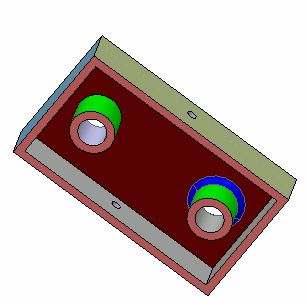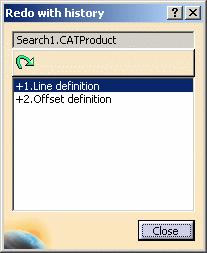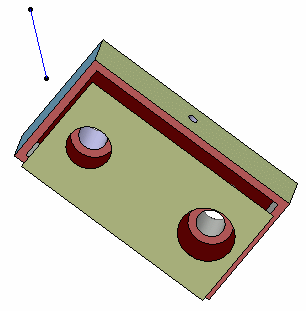 |
-
Open at least one object and reverse actions that can be
recovered.
| In this scenario, the object looks like this: |
 |
-
Click
Redo
 in the Standard toolbar or select Edit > Redo xxx
(or press Ctrl+Y), "xxx" corresponding to the name of the
last action undone.
in the Standard toolbar or select Edit > Redo xxx
(or press Ctrl+Y), "xxx" corresponding to the name of the
last action undone.
-
If you want to recover the last action more than once,
repeat step 1 as many times as required.
When there is no action to recover,
Redo is replaced by Repeat, enabling you in
the right conditions to restart a command that you just used.
However, when a command run in repeat mode is interrupted, it is
automatically restarted afterwards and this, even if you click
Cancel. The only way to interrupt a command in repeat
mode is to select another command (such as Select, for
instance). |
-
If you want to
display an history of actions that can be recovered in the active
document, click Redo with history
 : :
 |
| The name of the document
in which you are about to recover actions is displayed at the top of
the dialog box (where you can see "Search1.CATProduct"). The
Redo with history dialog box lets you choose the actions
you wish to recover from the numbered list displayed in the bottom
part, the most recently reversed action being displayed at the top of
the list. |
Each action is
identified by its name, for instance "(Paste Special)" refers to
Edit > Paste Special. Action names corresponding to an
internal transition inside a command (e.g. "Select search
results...") are followed by ... to distinguish them from
global commands.
You can reverse then recover internal transitions as long as you are in
the command. If several Undo actions are performed successively
until the command itself is reversed, then you cannot recover its
internal transitions.
For instance, suppose the following scenario with two different
cases:
- step 1: copy an object
- step 2: paste the object
- step 3: select the object then move it
Case 1
Click Undo: this moves the object back to its original
position in step 2.
Click Redo: this moves the object to the location
defined in step 3.
You can reverse then recover the move since you are still in the
Select command.
Case 2
Click Undo: this moves the object back to its original
position in step 2.
Click Undo once again: the paste action is canceled
and you go back to step 1.
Click Redo: the object is pasted.
But you cannot recover step 3 after this and if you display the
history, you can see that it is empty. You cannot recover the move
because the second reversal impacts the Paste command and
not the Select command anymore. |
 |
If you want to recover the first
action only, simplyo click Redo
 because the first
action is already highlighted in the list: the action is recovered
and removed from the history.If you want to recover the first four actions, all you need
to do is click the last action to be recovered (i.e. the fourth
one in our example): clicking an action implies that all former
actions are selected as well and thus, recovered in order to keep
the history.If you change your mind and decide to recover the first two
actions instead, click the second action in the list: only the
first two actions are selected and not the first four anymore.
because the first
action is already highlighted in the list: the action is recovered
and removed from the history.If you want to recover the first four actions, all you need
to do is click the last action to be recovered (i.e. the fourth
one in our example): clicking an action implies that all former
actions are selected as well and thus, recovered in order to keep
the history.If you change your mind and decide to recover the first two
actions instead, click the second action in the list: only the
first two actions are selected and not the first four anymore. |
| Bear in mind that one
history is used per document ; the history of actions is not
forwarded from one document to another. As a consequence, recovering
actions in a document opened several times simultaneously (e.g.
when opening a CATPart and a CATProduct containing this CATPart)
may corrupt data. It is recommended not to recover actions in a
document that has been modified in another window. |
-
When satisfied with your selection, click Redo
 to recover all the selected
actions.The dialog box stays open and you can keep on recovering actions. to recover all the selected
actions.The dialog box stays open and you can keep on recovering actions.
| In this scenario, "Offset definition" has been selected
in the right column which means that the line and offset
creation has been recovered. The result now looks like this: |
 |
-
To close the Redo with history dialog box,
click Close.
|